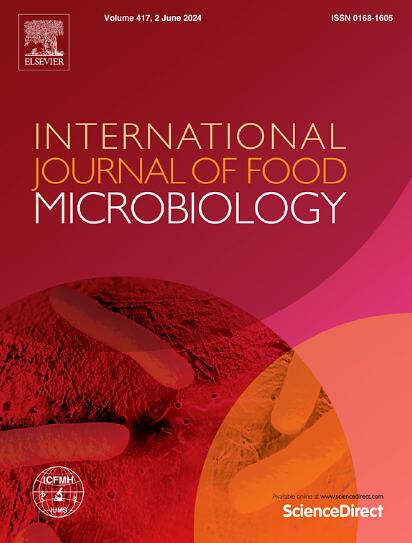Genetic relatedness of Staphylococcus aureus isolates within food outbreaks by single nucleotide polymorphisms
IF 5
1区 农林科学
Q1 FOOD SCIENCE & TECHNOLOGY
International journal of food microbiology
Pub Date : 2025-02-18
DOI:10.1016/j.ijfoodmicro.2025.111115
引用次数: 0
Abstract
Investigation of bacterial food outbreaks by whole genome sequencing can rely on the inspection of the genetic relatedness between isolates through the application of single nucleotide polymorphism (SNP) thresholds. However, there is no consensus for Staphylococcus aureus in the context of food outbreaks. In this study, we propose a SNP cut-off by taking into account the mutation rate and the evolution time of this pathogen in food. Through in vitro microevolution, we determined the mutation rate of three S. aureus strains grown under mimicked food stressing conditions. From the mutation rate, we set a cut-off of 28 SNPs considering 30 days as evolution time based on the average shelf-life of foods contaminated by S. aureus and the timeline for identifying this pathogen in outbreaks. The SNP threshold was applied to retrospectively study ten staphylococcal food outbreaks to assess whether isolates from food and/or of human origin from the same outbreak were epidemiologically related. To interpret SNP distances, phylogenetic tree topologies and bootstraps were integrated and showed that isolates differing by up to 28 SNPs were monophyletic. Our suggested cut-off can be used in outbreak management to identify closely related S. aureus strains.
通过单核苷酸多态性分析食物暴发中金黄色葡萄球菌分离株的遗传相关性
利用全基因组测序技术调查细菌性食品暴发,可以通过应用单核苷酸多态性(SNP)阈值检验分离物之间的遗传亲缘关系。然而,对于金黄色葡萄球菌在食品暴发中的作用尚未达成共识。在本研究中,我们通过考虑该病原体在食品中的突变率和进化时间,提出了一个SNP截止值。通过体外微进化,我们确定了在模拟食物胁迫条件下生长的三种金黄色葡萄球菌菌株的突变率。从突变率来看,我们根据金黄色葡萄球菌污染食品的平均货架期和疫情中发现该病原体的时间,考虑30天的进化时间,设定了28个snp的截止时间。应用SNP阈值对10次食物葡萄球菌暴发进行回顾性研究,以评估来自同一暴发的食物和/或人类来源的分离株是否具有流行病学相关性。为了解释SNP距离,我们整合了系统发育树拓扑结构和自举图,结果表明,存在多达28个SNP差异的分离株是单系的。我们建议的切断可用于疫情管理,以确定密切相关的金黄色葡萄球菌菌株。
本文章由计算机程序翻译,如有差异,请以英文原文为准。
求助全文
约1分钟内获得全文
求助全文
来源期刊
CiteScore
10.40
自引率
5.60%
发文量
322
审稿时长
65 days
期刊介绍:
The International Journal of Food Microbiology publishes papers dealing with all aspects of food microbiology. Articles must present information that is novel, has high impact and interest, and is of high scientific quality. They should provide scientific or technological advancement in the specific field of interest of the journal and enhance its strong international reputation. Preliminary or confirmatory results as well as contributions not strictly related to food microbiology will not be considered for publication.

 求助内容:
求助内容: 应助结果提醒方式:
应助结果提醒方式:


